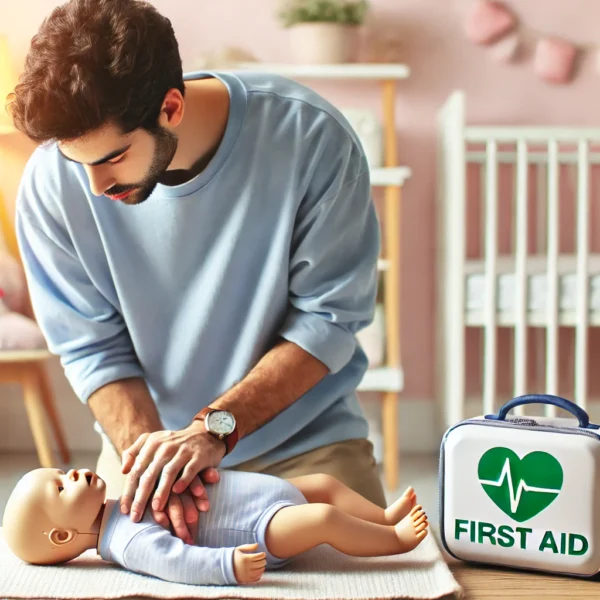Essential First Aid for Newborns: A Guide to Baby Care and Emergency Response

First Aid for Babies: Essential Newborn Baby Care
Taking care of a newborn baby is a delicate responsibility, and knowing how to provide first aid in an emergency is crucial for parents and caregivers. Here’s a guide on basic first aid techniques and safety measures for newborns:
1. Choking
Newborns may choke on milk, mucus, or small objects. It’s important to act quickly but calmly.
- Signs of Choking: Difficulty breathing, coughing, wheezing, or turning blue.
- What to Do:
- Place the baby face-down along your forearm, with their head lower than their chest.
- Support the baby’s head and neck.
- Give 5 firm back blows between the shoulder blades with the heel of your hand.
- If the object is not dislodged, turn the baby over, give 5 chest thrusts using two fingers in the center of the chest just below the nipple line.
- Repeat the process if necessary and call for emergency help.
2. CPR (Cardiopulmonary Resuscitation)
If a newborn stops breathing or their heart stops, immediate CPR can be lifesaving.
- Steps for Infant CPR:
- Check for responsiveness: Gently tap the baby’s feet and shout their name.
- Check breathing: Look for chest movement. If the baby is not breathing, call for emergency help.
- Chest compressions: Place two fingers in the center of the baby’s chest and compress about 1.5 inches deep at a rate of 100-120 compressions per minute.
- Rescue breaths: After every 30 compressions, give 2 gentle breaths. Seal your mouth over the baby’s nose and mouth, blowing just enough to see the chest rise.
- Continue CPR until the baby shows signs of life or help arrives.
3. Burns
Newborns have very sensitive skin, so even mild burns can be serious.
- For minor burns:
- Cool the burn immediately with cool (not cold) water for 10-20 minutes.
- Avoid applying ice or butter.
- Cover the burn with a sterile, non-stick bandage.
- Seek medical attention for any burns on the face, hands, feet, or genitals, or if the burn is larger than the baby’s hand.
4. Fever
A high fever in a newborn (above 100.4°F or 38°C) can be a sign of infection and should be treated as an emergency.
- What to Do:
- Check the baby’s temperature with a digital thermometer.
- Remove excess clothing and offer fluids (breast milk or formula).
- Never give newborns medication without a doctor’s approval.
- Seek immediate medical care if the fever persists or if the baby shows signs of lethargy, irritability, or difficulty feeding.
5. Nosebleeds
Nosebleeds can occur if a newborn’s nasal passages are dry or irritated.
- What to Do:
- Gently tilt the baby’s head forward (not backward) to prevent swallowing blood.
- Pinch the soft part of the baby’s nose with a tissue for 5-10 minutes.
- Avoid inserting anything into the baby’s nose.
- If bleeding continues for more than 20 minutes, seek medical attention.
6. Falls
Accidental falls can happen, especially when babies begin to roll. Head injuries in newborns should always be taken seriously.
- What to Do:
- Check for any visible injuries, swelling, or changes in behavior.
- If the baby is unconscious, vomiting, or has difficulty moving, call emergency services immediately.
- If the baby is crying but otherwise responsive, monitor them closely and consult a doctor for advice.
7. Poisoning
Newborns are unlikely to ingest harmful substances, but it’s important to be aware of potential hazards.
- What to Do:
- If you suspect the baby has ingested something toxic, call Poison Control immediately.
- Do not induce vomiting unless advised by a medical professional.
- Bring the substance (if known) to the hospital for proper identification.
8. Insect Bites or Stings
Newborns can be sensitive to insect bites or stings, which may cause an allergic reaction.
- What to Do:
- Wash the area with soap and water.
- Apply a cold compress to reduce swelling.
- Monitor for signs of an allergic reaction (swelling of the face, difficulty breathing).
- Seek medical help if there are signs of an allergic reaction.
9. Diaper Rash
Though not an emergency, diaper rash can be uncomfortable for newborns.
- What to Do:
- Change diapers frequently to keep the area dry.
- Use a diaper rash cream with zinc oxide to protect the skin.
- Let the baby have diaper-free time to allow air to circulate.
- If the rash persists or worsens, consult a pediatrician.
10. Cuts and Scrapes
Minor cuts or scrapes can happen even to newborns.
- What to Do:
- Clean the area with mild soap and water.
- Apply an antiseptic ointment to prevent infection.
- Cover the wound with a clean, sterile bandage.
- If the cut is deep or doesn’t stop bleeding, seek medical care.
Preventive Measures:
- Baby-proof the home by removing small objects, keeping harmful substances out of reach, and using safety equipment like baby gates.
- Learn infant first aid and CPR by taking a certified course to build confidence in handling emergencies.
- Monitor newborns closely during feedings, diaper changes, and sleep to prevent accidents like choking or suffocation.
By knowing these essential first aid tips and preventive measures, parents and caregivers can ensure that their newborns are safer and better cared for in any situation. It’s always advisable to seek professional medical advice when in doubt, as babies are particularly vulnerable and need special attention.



